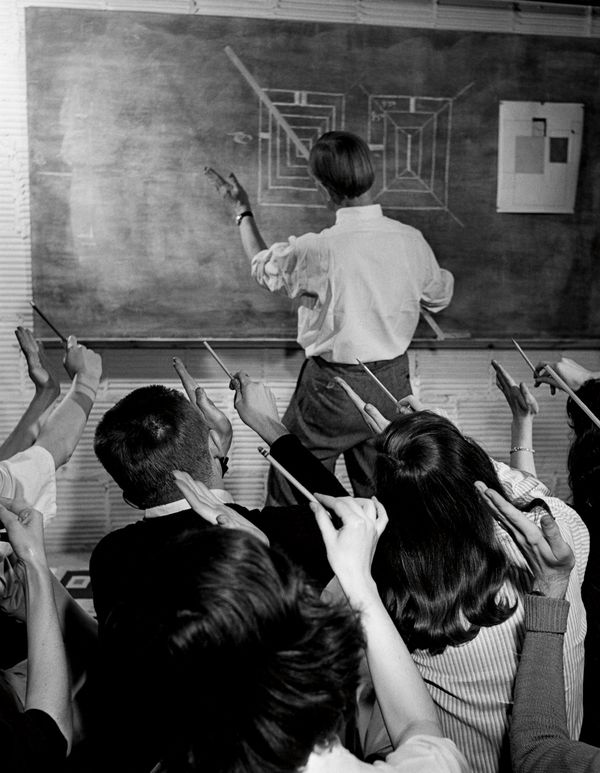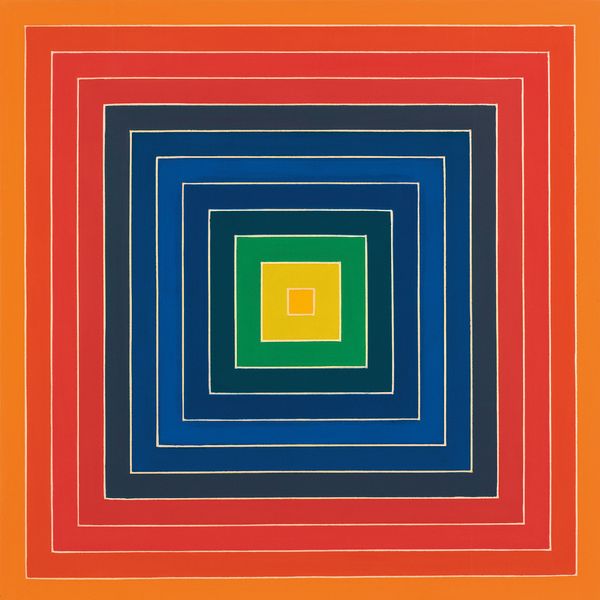Artist Josef Albers with his class at Black Mountain College, shot for Life magazine © Photo by Genevieve Naylor / Corbis via Getty Images
"Our concern is the interaction of colour; that is, seeing what happens between colours. We are able to hear a single tone. But we almost never (that is, without special devises) see a single colour unconnected and unrelated to other colours. Colours present themselves in continuous flux, constantly related to changing neighbours and changing conditions."
—Josef Albers, from Interaction of Colour, 1963
Departing from the Abstract Expressionist trends of his time, Josef Albers' life work was centered around colour experimentation — the artist's search for and examination of colour interaction and perception is embodied in the series 'Homage to the Square', begun in 1950 and spanning over the final 26 years of his life. His exhaustive exploration of colour was a defining part of his oeuvre, from his early career at the Bauhaus in Germany, to his teaching position at the revolutionary Black Mountain College in North Carolina, to teaching, among others, Willem de Kooning, Robert Rauschenberg and Robert Motherwell as the Head of the Department of Design at Yale.
These [red] paintings were so cherished by the artist and his wife that they were intentionally never sold in their lifetime.
Josef Albers Study for Homage to the Square: Wet and Dry, 1969
This particular work from our upcoming 20th Century & Contemporary Art Evening Sale, 1969's Study for Homage to the Square: Wet and Dry, is an illuminating example of the red paintings in his series. With the red hues symbolising passion and love, these paintings were so cherished by the artist and his wife that they were intentionally never sold in their lifetime.
The viewer's gaze is drawn solely to the interplay of colour, as the artist strips away any compositional complexity by combining the colours in a strictly regimented structure of squares. The sole concern is colour, explored through purity of shapes, structure and colours themselves. The scientific approach taken by the artist — in his examination of chromatic interplay in its purest forms — is further emphasised by the fact that the exact hues used are quoted on the reverse of each painting together with the method of application: "all in one primary coat, directly from the tube." Each square is set within the next, with the tones creating the illusion of three-dimensionality as if the squares are at once coming out towards the viewer and departing deep within the work.
Frank Stella Untitled, 1974 © Frank Stella. ARS, NY and DACS, London 2016. Image: Private Collection / Bridgeman Images
Study for Homage to the Square: Wet and Dry perfectly exemplifies Albers' fascination with illusion conveyed by contiguous chromatic fields and people's colour perceptions: "If one says 'red' — the name of color — and there are fifty people listening, it can be expected that there will be fifty reds in their minds. And one can be sure that all these reds will be very different," Albers stated in Yale University Press' Interplay of Colours from 1963. Executed some 19 years into his 'Homage' series, this work underlines the defining messages of Albers' oeuvre as the viewer sharpens his focus to discern the precise borders between the hues. The work drives us to intensify our perceptions to become more sensitive to the world around us.
Scholar Nicholas Fox Weber wrote in 1988, "As a teacher, Albers was to emphasize the value of 'maximum effect from minimum means'" — and our upcoming lot leaves no doubt that Albers succeeded in this endeavour.


